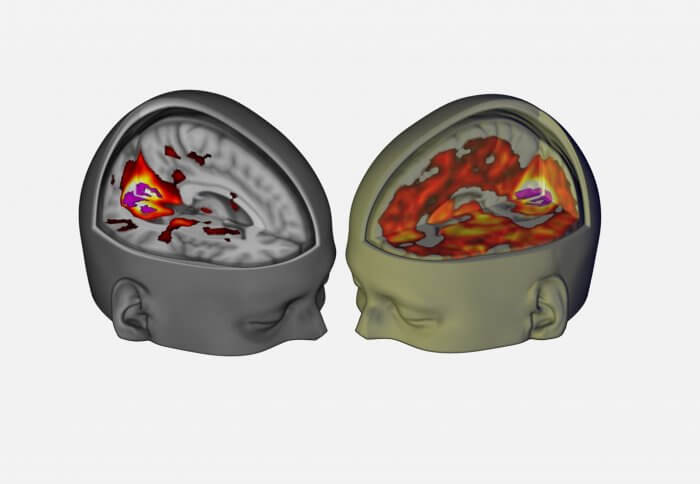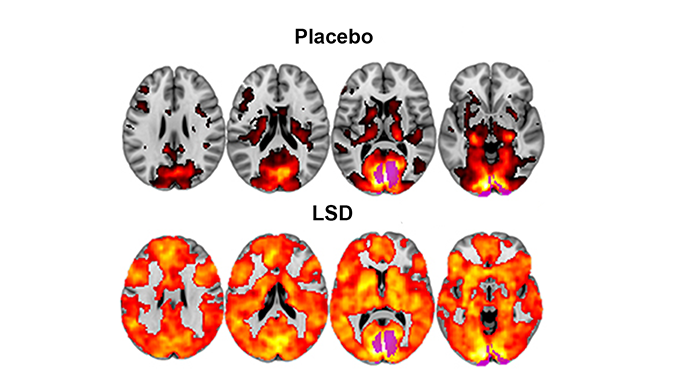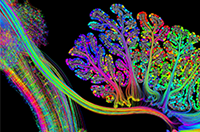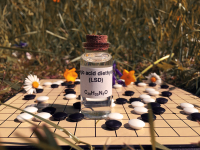
The World’s First Images of the Brain on LSD
For the first time in history, the effects of LSD on the human brain have been revealed using cutting-edge brain imaging technology. Conducted by the Beckley/Imperial Research Programme, this landmark study provides a window into the mechanisms behind many of the subjective experiences associated with LSD, such as visual hallucinations and a sense of ‘ego-dissolution’, and offers invaluable insights into how these effects may be harnessed for therapeutic means.
Published in the Proceedings of the National Academy of Sciences (PNAS), the findings show how the drug decreases communication between the brain regions that make up the Default Mode Network (DMN), a collection of hub centres that work together to control and repress consciousness. Like the conductor in an orchestra, the DMN polices the amount of sensory information that enters our sphere of awareness, and has been described as the neural correlate of the ‘ego’.

Increase in the brain connectivity after LSD (right), compared to placebo (left).
Yet the DMN disintegrates under LSD, allowing for a magnificent increase in communication between brain networks that are normally highly segregated. This produces a more integrated pattern of connectivity throughout the entire brain, producing more fluid modes of cognition and enriching consciousness. Results of the study show that the magnitude of this effect is directly correlated to the the strength of the subjective experience of ‘ego-dissolution’ and feeling of oneness and unity. This could have major implications for LSD-assisted psychotherapy, as it indicates how the drug allows patients to break free from the rigid modes of cognition and thought that underlie hard-to-treat conditions such as depression and addiction.
Dr. Robin Carhart-Harris of the Beckley/Imperial Research Programme explained how “this effect underlies the profound altered state of consciousness that people often describe during an LSD experience. It is also related to what people sometimes call ‘ego-dissolution’, which means the normal sense of self is broken down and replaced by a sense of reconnection with themselves, others and the natural world. This experience is sometimes framed in a religious or spiritual way – and seems to be associated with improvements in well-being after the drug’s effects have subsided.”
To conduct the research, the team recruited 20 volunteers, each of whom was then administered either 75 micrograms of LSD or placebo before having their brains scanned using various techniques including fMRI and magnetoencephalography (MEG).
The resulting images showed how the brain’s visual cortex, which normally receives and processes information from the eyes, begins to communicate with a wide range of other brain regions under the effects of LSD. This means that many brain regions that aren’t normally involved in vision suddenly contribute to visual processing, which explains why people tend to experience dreamlike hallucinations when they use the drug.

This image shows how, with eyes-closed, much more of the brain contributes to the visual experience under LSD than under placebo. The magnitude of this effect correlated with participants reports of complex, dreamlike visions.
“We observed brain changes under LSD that suggested our volunteers were ‘seeing with their eyes shut’ – albeit they were seeing things from their imagination rather than from the outside world. We saw that many more areas of the brain than normal were contributing to visual processing under LSD – even though the volunteers’ eyes were closed. Furthermore, the size of this effect correlated with volunteers’ ratings of complex, dreamlike visions,” explained Carhart-Harris.
While there’s plenty more work to be done before the effects of LSD are fully understood, this research marks a watershed moment in the history of psychedelic science, illuminated key pathways towards increasing the wellbeing of humanity through the use of these compounds.
Amanda Feilding, founder and co-director of the Beckley/Imperial Research Programme, summed up the significance of this research by stating that “we are finally unveiling the brain mechanisms underlying the potential of LSD, not only to heal, but also to deepen our understanding of consciousness itself.”
Podcast
- All
Links
- All
Support
- All
BIPRP
- All
Science Talk
- All
Amanda's Talks
- All
- Video Talk
- Featured
- 2016 Onwards
- 2011-2015
- 2010 and Earlier
- Science Talk
- Policy Talk
One-pager
- All
Music
- All
Amanda Feilding
- All
Events
- All
Highlights
- All
Psilocybin for Depression
- All
Current
- All
Category
- All
- Science
- Policy
- Culture
Substance/Method
- All
- Opiates
- Novel Psychoactive Substances
- Meditation
- Trepanation
- LSD
- Psilocybin
- Cannabis/cannabinoids
- Ayahuasca/DMT
- Coca/Cocaine
- MDMA
Collaboration
- All
- Beckley/Brazil Research Programme
- Beckley/Maastricht Research Programme
- Exeter University
- ICEERS
- Beckley/Sant Pau Research Programme
- University College London
- New York University
- Cardiff University
- Madrid Computense University
- Ethnobotanicals Research Programme
- Freiburg University
- Medical Office for Psychiatry and Psychotherapy, Solothurn
- Beckley/Sechenov Institute Research programme
- Hannover Medical School
- Beckley/Imperial Research Programme
- King's College London
- Johns Hopkins University
Clinical Application
- All
- Depression
- Addictions
- Anxiety
- Psychosis
- PTSD
- Cancer
- Cluster Headaches
Policy Focus
- All
- Policy Reports
- Advisory Work
- Seminar Series
- Advocacy/Campaigns
Type of publication
- All
- Original research
- Report
- Review
- Opinion/Correspondence
- Book
- Book chapter
- Conference abstract
- Petition/campaign
Search type

